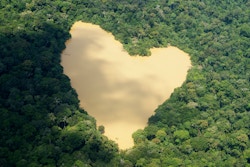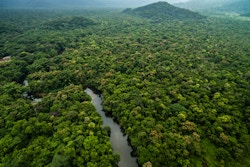The Congo Basin rainforest: The lungs of Africa
The Congo Basin rainforest is one of Earth’s wilderness strongholds, often dubbed “The lungs of Africa» due to its ecological significance. Mostly shielded from the destruction suffered by other rainforests across the globe, its unique resilience is faltering fast. Can we stop the destruction before it is too late?


Quenching the thirst with a sip of water from a leaf in the amazing Congo Basin rainforest.
Photo: Julie Forchhammer/RFN

A home to 90 million people. 40 million in the Democratic Republic of the Congo (DRC) alone.
Two million are Indigenous peoples.
Photo: Shutterstock

A biological treasure trove.
Many plant and animal species are endemic. Such as the elusive Okapi, living in Northern DRC and almost impossible to photograph in the wild.
Photo: Johan Wildhagen

A cure for diseases. 70% of cancer medicines with active ingredients derived from plants come from plants that are found only in the rainforest.
Perhaps the key ingredient for the next pandemic vaccine lies hidden in a tree or an insect in The Congo Basin?
Photo: Shutterstock

A key to solving the nature and climate crises.
To our common future across the globe.
Photo: Alexis Huguet

VAST: The Congo Basin rainforest covers an area the size of Alaska. Map: Kartoteket/RFN
The Congo Basin rainforest is second only to the Amazon rainforest in size, spanning about 2 million square kilometers – an area comparable to Alaska.
It is named after the mighty Congo River that runs through it, and it contains nearly 70% of the forest cover on the entire African continent.
The rainforest stretches across six Central African countries: The Republic of the Congo, The Central African Republic, Cameroon, Gabon, Equatorial Guinea, and The Democratic Republic of the Congo (DRC). We work in DRC – which alone hosts more than 60% of the rainforest.
The Congo Basin rainforest has stood tall and resilient for millions of years – shielded from the massive destruction suffered by rainforest across the globe.
However, in the new millennium, the balance has shifted.
State of the African rainforests
State of the remaining Congo Basin rainforest*:
*We do not have historical numbers on the size of the original, intact Congo Basin rainforest.
Source: State of the Rainforest, 2020

TRANSPORT: Tropical timber transport in DR. Congo. Photo: Lionel Diss/RFN
The rainforest is being destroyed at alarming rates – threatening to ruin its ability to regenerate.
We are reaching a tipping point.
Threats to the Congo Basin: An economy of destruction
The Congo Basin is being choked by an economy that is devouring its resources:
- Slash and burn small scale agriculture
- Industrial agriculture and plantations
- Mining and logging
- Charcoal and, increasingly, oil production
- Urbanization and new infrastructure such as roads



THREATS: Mining. Photo: Alexis Huguet/RFN, Logging. Photo: Lionel Diss/RFN, Slash and burn agriculture. Photo: Chris Scarffe/Synchronicity Earth
The role of poverty
Most people in the region are among the world’s poorest people, who need the rainforest to source food and water, building materials and fuel. The sheer volume of forest dependent people plays a significant role in deforestation:
In the Amazon and Asia and Oceania, the main drivers of forest loss are farming on an industrial scale.
In the Congo Basin, it is overwhelmingly small-scale, non-mechanized farming and clearing for charcoal production by local communities – as much as 84% between 2000 and 2014, according to a 2018 study published in Science Advances.
Thus, to change destructive practices on the ground, we must shift basic societal structures – in economy, policy, and power.

DISPLACED: Displaced people fleeing conflict between the Congolese army and M23 rebels, Democratic Republic of Congo - 21 May 2012. Photo: Susan Schulman/Shutterstock
The role of conflict
In 2003, decades of civil war ended in a peace treaty. However, the peace proved fragile, and conflict has ebbed and flowed ever since.
Rebels, state forces and foreign actors have legally and illegally exploited minerals, timber, and other forest-derived resources, to finance or sustain conflict.
Enforcing or strengthening laws and regulations protecting people’s rights and nature becomes secondary to ending conflicts.

Thus conflict has become a major driver for deforestation in The Congo Basin.
Photo: Lionel Diss/RFN
Size matters
Human activity does not just make the rainforests shrink.
Infrastructure and roads, logging, mining and agriculture fragment them into isolated patches.
That is a threat in itself.
The size of the rainforest is directly related to its ability to maintain ecological balance, support biodiversity and provide life-sustaining ecosystem services.
If we lose the last contiguous rainforests, we lose the fight against climate change and biodiversity loss.

That is why Rainforest Foundation Norway focuses on the three largest, contiguous rainforests left on the planet – in South America, Central Africa and Southeast Asia & Oceania.
Photo: Alexis Huguet/RFN
How we work in DRC - promoting structural change
In the Democratic Republic of the Congo, we work along four pathways to shift the structures that threaten forests and people:
- Securing land rights for indigenous peoples
- Creating political change
- Making businesses sustainable
- Working with local communities to secure climate funding

Defending forests means defending the people who live with and protect them. It is about conservation, but also justice, culture, and identity.
Photo: Johan Wildhagen
Rights-based protection
Recognition of Indigenous peoples’ rights to their traditional lands is proven to be extremely effective in protecting the rainforest. Rainforest Foundation Norway is one of the world’s leading organizations in the field of rights-based rainforest protection

Everything we do, we do with local civil society partners across the Congo Basin.
Photo: Julie Forchhammer/RFN
An example of a current rights-based project in The Congo Basin: A game changer for climate funding.

COMMUNITY-LED: Women from the village of Penzele in the DRC discussing forest protection in 2019. Photo: Alexis Huguet/RFN
In DRC, we support a pioneering initiative to channel climate funds to grassroot efforts. Indigenous peoples and local communities are highly efficient conservators of the rainforest, yet they receive less than 1% of climate funding.
The Community Fund for Forests aims to rectify this. Located in the Democratic Republic of the Congo (DRC), it provides a local organizing hub to directly administer funding where it is needed the most, in a part of the world that we all depend upon.

Did you know?
The Congo Basin, whose rainforest is second only to that of the Amazon in size, is an enormous treasure trove burgeoning with life and natural resources:
- The Congo River is the second largest in the world by discharge, winding through Central Africa and providing water and life to the rainforest.
- The rainforest of the Congo Basin is home to 600 different species of trees and about 8000 species of plants, of which a third are not found anywhere else on Earth.
- It is home to 400 known species of mammals, 700 species of fish, 900 species of butterflies, 1200 species of birds and 300 species of reptiles.
- The area stores 8 per cent of all the carbon present in the world’s forests.
- 90 million people live in this region and are dependent on the rainforest.
- In DR Congo alone, some 40 million of the country’s 70 million inhabitants depend on the rainforest for their livelihood.
- DR Congo is also home to as many as two million Indigenous peoples.







